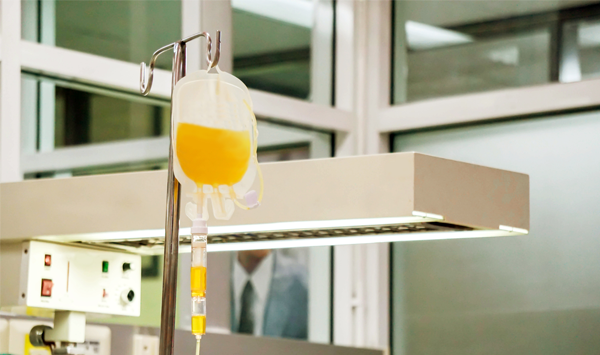10 Sep 2020
ASCOT blog: Convalescent plasma for COVID-19
Written by Associate Professor Zoe McQuilten, Monash University. First published by the Australasian COVID-19 Trial (ASCOT).
On 23 August, the US Food and Drug Administration (FDA) issued an emergency use authorisation (EUA) for convalescent plasma collected from individuals who have recovered from COVID-19 (COVID-19 convalescent plasma). This has generated much interest in convalescent plasma as a therapy for COVID-19. Convalescent plasma is a treatment arm in ASCOT. Participants are randomised (like the flip of a coin) to either receiving convalescent plasma or the usual best standard of care without convalescent plasma.
What is convalescent plasma?
Most people who recover from COVID-19 develop antibodies (proteins that the immune system produces in response to infection) to SARS-CoV-2. Antibodies are found in plasma, the yellow liquid portion of blood. Plasma is collected from donors who have recovered from COVID-19 and this plasma can then be infused to people currently suffering from acute COVID-19 infection. The idea is prior to a patient being able to mount a strong antibody response, we can give their immune system a boost by providing antibodies from someone who has already recovered and whose immune system has already done the work.
The journal, JAMA, has provided a patient page to explain convalescent plasma further.

Why is convalescent plasma being studied for COVID-19?
Convalescent plasma has been successfully used as a therapy for other infections, including pneumococcal pneumonia, measles, mumps and hepatitis A and B. It is an appealing therapy to study in a pandemic, as it is can be made available relatively early during the course of a pandemic, whilst other treatments are being developed, and the safety profile of clinical plasma is well-characterised. A systematic review of convalescent plasma for other severe respiratory infections concluded that convalescent plasma may reduce mortality, but that the evidence base is not conclusive due to most studies being small and at high risk of bias (Mair-Jenkins et al., 2015).
Since the beginning of the COVID-19 pandemic, most countries have started collection and manufacture of convalescent plasma to investigate it as a therapy for COVID-19.
What is the current evidence for the efficacy of convalescent plasma for COVID-19?
While thousands of patients have already received convalescent plasma for treatment of COVID-19 internationally, this has been mostly outside of randomised clinical trials, and therefore data on its efficacy remains very limited.
There are four randomised controlled trials comparing convalescent plasma with standard of care that have been reported, however only one has been published in a peer-reviewed journal to date. Three of these trials closed early, (Li et al., 2020)(Gharbharan, 2020)(Avendano-Sola,2020) and due to their small sample sizes (ranging 81 to 103 patients) were underpowered to determine whether there is a benefit from convalescent plasma. The largest trial, which enrolled 452 patients with moderately severe COVID-19, found no difference in their primary outcome (death or progression to severe disease within 28 days). However, the study was powered to detect a 9% absolute reduction in their primary outcome, and a smaller effect due to convalescent plasma cannot be excluded. The authors did report improvement in some of their secondary outcomes in the convalescent plasma treated patients.
The COVID-19 Plasma Consortium in US has reported mortality outcomes from 35,322 patients treated with convalescent plasma. Unfortunately, this was an observational study without a control group, which has not yet been peer-reviewed. Patients appeared to benefit when the convalescent plasma was given earlier and when it contained higher levels of antibodies against SARS-CoV-2. However, because this was an observational study (not a randomised controlled trial) there remains uncertainty as to whether convalescent plasma was beneficial overall.
What data is there on the safety of convalescent plasma?
Transfusion of clinical plasma has known risks, including transfusion-related lung injury (TRALI), circulatory overload (TACO), allergic reactions, and transfusion-transmitted infections. The same authors from the COVID-19 Plasma Consortium have reported their results on safety. They measured serious adverse events within four hours of transfusion in 5000 convalescent plasma recipients. In their report of the first 5000 recipients, the incidence of serious adverse events in the first hours after transfusion was low at less than 1%, including mortality rate (0.3%) (Joyner et al., 2020). Of the 36 reported serious adverse events, there were seven cases of TACO, 11 TRALI and three severe allergic transfusion reactions. However, only two were judged as definitely related to the convalescent plasma. In the completed randomised controlled trials, there were similar numbers of adverse events in each treatment arm.
Why we need trials of convalescent plasma for COVID-19
Currently, we have some information on the safety of convalescent plasma, albeit with minimal comparator data from controlled trials, and the evidence for its efficacy is limited to four small RCTs, three of which were terminated early.
We believe it is important that we demonstrate efficacy of convalescent plasma before it is made widely available – although relatively safe, administration of convalescent plasma, like any blood transfusion, is not without risk. Provision of convalescent plasma also requires the resources of our blood services to collect, test and manufacture this blood product at a time when all health services are under increased pressure due to the pandemic. This is especially important in low to middle income countries, where blood supplies may be less secure. Importantly, we also have an ethical obligation to our blood donors, and an expectation outlined in the National Stewardship Statement, to ensure that we use blood products for appropriate indications, supported by evidence.
For up to date information on current evidence for convalescent plasma there is a Cochrane living systematic review, as well as summaries of evidence provide by the COVID-19 taskforce.
Australia Red Cross Life Blood provides further information. In particular, if you have recovered from COVID-19 and would like to consider donating plasma, please find more information and contact Life Blood via the website or call 13 14 95.


